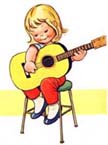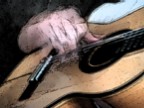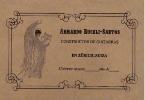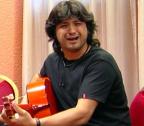Welcome to one of the most active flamenco sites on the Internet. Guests can read most posts but if you want to participate click here to register.
This site is dedicated to the memory of Paco de Lucía, Ron Mitchell, Guy Williams, Linda Elvira, Philip John Lee, Craig Eros, Ben Woods, David Serva and Tom Blackshear who went ahead of us.
We receive 12,200 visitors a month from 200 countries and 1.7 million page impressions a year. To advertise on this site please contact us.
|

|
|
Soundboards: tap-tones, flexing, grain patterns
|
You are logged in as Guest
|
|
Users viewing this topic: none
|
|
Login  | |
|

 
JBASHORUN
Posts: 1839
Joined: Jan. 23 2005

|
 Soundboards: tap-tones, flexing, gra... Soundboards: tap-tones, flexing, gra...
|
|
|
Hi everyone,
I was reading a post by a luthier recently... I think it was in the thread regarding how to achieve "The Conde Sound". In it, he mentioned that in achieving the desired tone, it was of great help if you knew how to use tap-tones and flexing to get the soundboard right.
Well, I've just bought myself a Euro Spruce soundboard. My decision for choosing this particular one, was because the grain pattern was very narrow/close together, and straight. Is this the right way of thinking?
What I would also be curious to know, is how I can use tap-tones and flexing to understand my soundboard....
Can I tap the soundboard pieces (even at this early stage, when they are in their raw, seperated form) and get any information from what I hear/feel?
And when I have finally joined the soundboard pieces, how can I use tapping and flexing to understand the state of the soundboard and its influence on the tone I am trying to achieve?
I do understand that this is quite a complex subject. And I plan to ask Pablo about it in more detail when I visit his workshop. But for the moment, if anyone can point me in the right direction, it would be appreciated.
Thanks!
James
_____________________________
¡Si esto no está en compas, esto no es el Flamenco!
|
|
|
|
REPORT THIS POST AS INAPPROPRIATE |
Date Nov. 20 2006 14:44:30
 |
|

   
JasonM
Posts: 2055
Joined: Dec. 8 2005
From: Baltimore

|
 RE: Soundboards: tap-tones, flexing,... (in reply to JBASHORUN) RE: Soundboards: tap-tones, flexing,... (in reply to JBASHORUN)
|
|
|
Poor Anders, this thread just won't die!
Here is the link from Cumpiano where he says that tap tuning is way over rated.
http://www.cumpiano.com/Home/Newsletters/Issues/newsletter10.html
Here is another link from Cumpiano explaining the general idea of tap tuning.
http://www.cumpiano.com/Home/Newsletters/Issues/newsletter%2019.htm
I just got the "Luthiers Handbook" yesterday, and practically read the whole thing while fighting off the flu.  This guy classifies guitar building into for parts, and emphasises the Tap Tuning part as being the most important in defining sound characteristics. While Cumpiano thinks it is not very important at all. This guy classifies guitar building into for parts, and emphasises the Tap Tuning part as being the most important in defining sound characteristics. While Cumpiano thinks it is not very important at all.
As a newb, I am of course very confused by all of this, but my intuiton tells me that trying to match the resonant frequency of soundboxes by shaving braces and using a strobe tuner would play little role in overall sound characteristics. Mabey aiming for a certain band of frequencies is the idea. Like aiming for a lower frequency range as opposed to a high, rather than going for an exact tone.
What I also fing confusing, is how Cumpiano describes "quenching" the bell-like tones of a free membrane sounboard. It seems pontless to go through this trouble, only to then sucure the sounboard to the back and start tinkering with the braces that you have already fiddles with inorder to achive some resonant frequency. I don't get it? Cumpaino seems to emphasize the former while discrediting the later.
|
|
|
|
REPORT THIS POST AS INAPPROPRIATE |
Date Feb. 10 2007 17:15:04
 |
|

  
Anders Eliasson
Posts: 5780
Joined: Oct. 18 2006

|
 RE: Soundboards: tap-tones, flexing,... (in reply to JBASHORUN) RE: Soundboards: tap-tones, flexing,... (in reply to JBASHORUN)
|
|
|
Jason
I´ve had a quick glance at this new taptone book and I wont recommend it. Its very much like Luthies handbook, just some more strobe tuners......
Listen:
If you can make an even soundboard and back, a square box and a correct neckangle, the guitar will play and sound........
Choose a relatively simple strut system. I will recommend for a first flamenco guitar, 5 braces, bridgepatch and 2 closing struts layed out more "normal" than Barberos plan.
Get a good spruce soundboard, German or Engelmann, doesnt matter, make it to around 2,1mm, make sure all braces are more or less same size and weight.
Back, cypress (Med, monterrey or CDN) make it around 2,4mm. Sides 2,5mm, thin neck, adjust the neckangle, so that with the fingerboard on, without frets, you can put a long straight edge on the fingerboard and you should have some 2mm between the straightedge and the soundboard where the bridge is going to be.
A bit of thinking helps but only to a certain degree.
Do this, and you´ll be prepared to build more. 
_____________________________
Blog: http://news-from-the-workshop.blogspot.com/
|
|
|
|
REPORT THIS POST AS INAPPROPRIATE |
Date Feb. 12 2007 7:38:09
 |
|

  
Anders Eliasson
Posts: 5780
Joined: Oct. 18 2006

|
 RE: Soundboards: tap-tones, flexing,... (in reply to JBASHORUN) RE: Soundboards: tap-tones, flexing,... (in reply to JBASHORUN)
|
|
|
quote:
So, I'm guessing that you personally don't tap tune your guitars? Do you do what Cumpiano talks about-- quench the bell like tones on the soundboard?
I do it my way, exactly what this article says. There are no golden "this is easy" rules" I tap, I listen, I take notes I do all I can to make my intuition as awake as possible. Thats the most important thing together with knowing when you are mentaly "there" or not. Some things you have to be in a certain mood (Zen) to do.
I´m building the so called natural way just like Cumpiano and this means I dont really believe much in all these tecnical helpers. They can be a help, but they certainly be a huge distraction as well. How many electronic strobe tuners did Stradivarius or Torres have.
And you are wrong, I´m not making this sound too easy, but I´m trying to make you build instead of complicating your own life. I wrote:
If you can make an even soundboard and back, a square box and a correct neckangle, the guitar will play and sound........
Choose a relatively simple strut system. I will recommend for a first flamenco guitar, 5 braces, bridgepatch and 2 closing struts layed out more "normal" than Barberos plan.
Get a good spruce soundboard, German or Engelmann, doesnt matter, make it to around 2,1mm, make sure all braces are more or less same size and weight.
Back, cypress (Med, monterrey or CDN) make it around 2,4mm. Sides 2,5mm, thin neck, adjust the neckangle, so that with the fingerboard on, without frets, you can put a long straight edge on the fingerboard and you should have some 2mm between the straightedge and the soundboard where the bridge is going to be.
If that sounds too easy to you, go ahead and build.... 
If you are not sure about your woodworking capacity, work wood instead of reading books about electronics. The old school says to build your jigs and molds before the instrument. Thats a VERY good advice. Its cheap and it´ll show you where you are. Next step, learn to sharpen tools and how to use them.
_____________________________
Blog: http://news-from-the-workshop.blogspot.com/
|
|
|
|
REPORT THIS POST AS INAPPROPRIATE |
Date Feb. 13 2007 8:25:45
 |
|
 New Messages New Messages |
 No New Messages No New Messages |
 Hot Topic w/ New Messages Hot Topic w/ New Messages |
 Hot Topic w/o New Messages Hot Topic w/o New Messages |
 Locked w/ New Messages Locked w/ New Messages |
 Locked w/o New Messages Locked w/o New Messages |
|
 Post New Thread
Post New Thread
 Reply to Message
Reply to Message
 Post New Poll
Post New Poll
 Submit Vote
Submit Vote
 Delete My Own Post
Delete My Own Post
 Delete My Own Thread
Delete My Own Thread
 Rate Posts
Rate Posts
|
|
|
Forum Software powered by ASP Playground Advanced Edition 2.0.5
Copyright © 2000 - 2003 ASPPlayground.NET |
0.109375 secs.
|


 Printable Version
Printable Version












 )
) 
 This guy classifies guitar building into for parts, and emphasises the Tap Tuning part as being the most important in defining sound characteristics. While Cumpiano thinks it is not very important at all.
This guy classifies guitar building into for parts, and emphasises the Tap Tuning part as being the most important in defining sound characteristics. While Cumpiano thinks it is not very important at all.  New Messages
New Messages No New Messages
No New Messages Hot Topic w/ New Messages
Hot Topic w/ New Messages Hot Topic w/o New Messages
Hot Topic w/o New Messages Locked w/ New Messages
Locked w/ New Messages Locked w/o New Messages
Locked w/o New Messages Post New Thread
Post New Thread